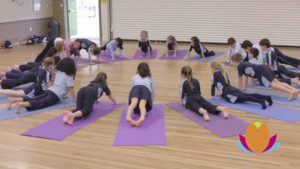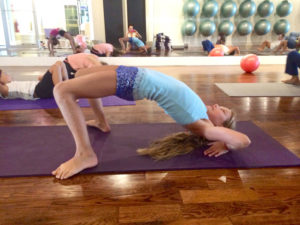
By John M. de Castro, Ph.D.
“Regular yoga practice can help reduce the level of sugar in the blood, along with lowering blood pressure, keeping a weight check, reducing the symptoms and slowing the rate of progression of diabetes, as well as lessening the severity of further complications.” – Art of Living
Type 2 diabetes is a common and increasingly prevalent illness that is largely preventable. Although this has been called adult-onset diabetes it is increasingly being diagnosed in children. It is estimated that 30 million people in the United States have diabetes and the numbers are growing. One of the reasons for the increasing incidence of Type 2 Diabetes is its association with overweight and obesity which is becoming epidemic in the industrialized world. Diabetes is the 7th leading cause of death in the United States. In addition, diabetes is heavily associated with other diseases such as cardiovascular disease, heart attacks, stroke, blindness, kidney disease, and circulatory problems leading to amputations. As a result, diabetes doubles the risk of death of any cause compared to individuals of the same age without diabetes. Type 2 Diabetes results from a resistance of tissues, especially fat tissues, to the ability of insulin to promote the uptake of glucose from the blood. As a result, blood sugar levels rise producing hyperglycemia.
A leading cause of this tissue resistance to insulin is overweight and obesity and a sedentary life style. Hence, treatment and prevention of Type 2 Diabetes focuses on diet, exercise, and weight control. Recently, mindfulness practices have been shown to be helpful in managing diabetes.
A mindfulness practice that combines mindfulness with exercise is yoga and it has been shown to be helpful in the treatment of Type II Diabetes. In today’s Research News article “Effects of Yoga in Adult Patients with Type 2 Diabetes Mellitus: A Meta-Analysis.” See:
or see summary below or view the full text of the study at: http://onlinelibrary.wiley.com/doi/10.1111/jdi.12548/epdf
Cui and colleagues review the published literature on the effects of yoga practice on Type II diabetes.
They found that yoga practice had significant positive effects on the patients, reducing fasting blood glucose, blood glucose after meals, glycosylated hemoglobin A1c (HbA1c), total cholesterol, and low-density lipoprotein cholesterol levels and increasing high- density lipoprotein cholesterol levels in the patients with Type II diabetes. In other words, yoga practice had markedly beneficial effects on blood sugar and cholesterol levels in the patient. Most of these measures are short-term indicators of the patient’s metabolic condition. HbA1c, on the other hand, is an indicator of long-term blood glucose control and suggests that yoga practice has lasting effects on the overall metabolic state of type II diabetic patients.
How yoga practice produces these effects is unknown. But, it is likely that, at least in part, the improvement is due to the fact that yoga is a moderate exercise and exercise is known to improve Type II diabetes. In addition, yoga practice reduces the physiological and psychological responses to stress and stress is known to exacerbate diabetes. Finally, yoga practice improves discipline and conscious appreciation of the bodily state. This may make it easier for the patient to successfully negotiate the rigorous dietary and lifestyle restrictions required for successful treatment of diabetes. Regardless of the mechanisms of action, it is clear that yoga practice is very helpful in controlling the metabolism of Type II diabetes patients.
So, improve type II diabetes with yoga.
“Yoga can decrease fasting blood glucose levels, lower blood pressure, improve cholesterol and triglycerides, reduce the need for diabetes medication, and lower stress hormone levels.1 What’s more, yoga increases flexibility and strength, improves balance and immune function, precipitates weight loss, relieves stress, and alleviates chronic pain.” – Jennifer Van Pelt
CMCS – Center for Mindfulness and Contemplative Studies
This and other Contemplative Studies posts are also available on Google+ https://plus.google.com/106784388191201299496/posts
Study Summary
Cui J, Yan JH, Yan LM, Pan L, Le JJ, Guo YZ. Effects of Yoga in Adult Patients with Type 2 Diabetes Mellitus: A Meta-Analysis. J Diabetes Investig. 2016 Jul 1. doi: 10.1111/jdi.12548. [Epub ahead of print]
Abstract
Aims/Introduction: A meta-analysis was performed to evaluate the efficacy of yoga in adult patients with T2DM.
Materials and Methods: The PubMed, EMBASE, and Cochrane databases were searched to obtain eligible randomized controlled trials (RCTs). The primary outcome was fasting blood glucose (FBG), and the secondary outcomes included glycosylated hemoglobin A1c (HbA1c), total cholesterol (TC), high-density lipoprotein cholesterol (HDL-C), low-density lipoprotein cholesterol (LDL-C), triglyceride, and postprandial blood glucose (PPBG). Weighted mean differences (WMDs) and 95% confidence intervals (CIs) were calculated. The I2 statistic represented heterogeneity.
Results: Twelve RCTs with a total of 864 patients met the inclusion criteria. The pooled WMDs were –23.72 mg/dl (95% CI: –37.78 to –9.65; P = 0.001; I2 = 82%) for FBG and –0.47% (95% CI: –0.87 to –0.07; P = 0.02; I2 = 82%) for HbA1c. The WMDs were –17.38 mg/dl (95% CI: –27.88 to –6.89; P = 0.001; I2 = 0%) for PPBG, –18.50 mg/dl (95% CI: –29.88 to –7.11; P = 0.001; I2 = 75%) for TC, 4.30 mg/dl (95% CI: 3.25 to 5.36; P < 0.00001; I2 = 10%) for HDL-C, –12.95 mg/dl (95% CI: –18.84 to –7.06; P < 0.0001; I2 = 37%) for LDL-C, and –12.57 mg/dl (95% CI: –29.91 to 4.76; P = 0.16; I2 = 48%) for triglycerides.
Conclusions: The available evidence suggests that yoga benefits adult patients with T2DM. However, considering the limited methodology and the potential heterogeneity, further studies are necessary to support our findings and investigate the long-term effects of yoga in T2DM patients.
http://onlinelibrary.wiley.com/doi/10.1111/jdi.12548/epdf








